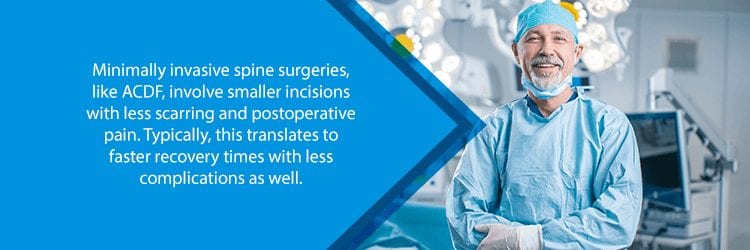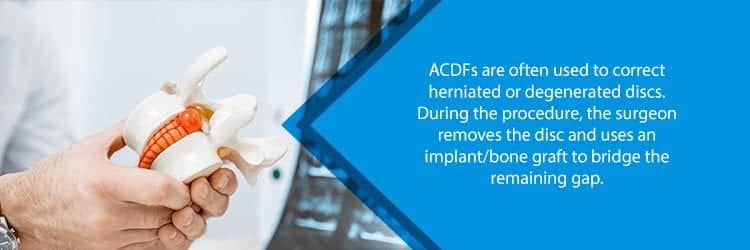Minimally invasive surgeries are a wonderful advancement in modern medicine. For comparison, think about the diagnostic methods that we used in the past vs. the sophisticated techniques that we use now. Before the advent of x-ray imaging, doctors relied on exploratory surgery. The only way to look inside the body was to cut into the area and probe for the underlying problem. Now, we have all of these wonderful tools, like CT scans and MRIs, that allow us to confirm diagnoses without ever having to wield a blade.
Minimally invasive spine surgery (MISS) is like that in a sense. However, doctors must still perform a procedure on the body, of course. Mere decades ago, the only options we had for surgery were massive undertakings that inherently led to bodily trauma. As a result, traditional or “open” procedures were rife with risks and complications. Not to mention, they took a long time from which to recover. Minimally invasive surgeries flip that concept on its head. In fact, some patients will leave the hospital on the same day as their procedures. Generally speaking, minimally invasive versions of traditional surgeries boast many advantages over other methods.
Today’s post will focus on the minimally invasive version of anterior cervical discectomy and fusion (ACDF). In particular, this procedure is ideal for those with damaged cervical discs that do not require more extreme interventions. To find out if you are an eligible candidate for ACDF, consult with your doctor.

What is Anterior Cervical Discectomy & Fusion (ACDF)?
The best way to break down these procedures is by looking at the name. In this instance, we have anterior cervical discectomy and fusion. So, let’s talk about that. Firstly, “anterior” refers to an approach from the front, while the term “cervical” involves the neck region of the spine. So, we know that this procedure must involve a frontal approach to the neck.
A discectomy is a type of surgery in which the goal is to remove a damaged intervertebral disc from the spine. If you’re not up to snuff with spinal anatomy, a disc is basically the soft cushion-like material that rests between the bones of the spine. Surgeons usually perform a discectomy in conjunction with a spinal fusion. Fusion surgery involves implanting a bone graft between two vertebrae in order to fuse them together over a period of time. Why? Eliminating movement at the source of pain tends to resolve the discomfort.
How is an ACDF Performed?
To perform an ACDF, the surgeon begins with a frontal approach via a small incision near the affected area. Because the surgery is minimally invasive, instead of cutting through soft tissues (like muscles), the surgeon gently moves them to the side. Moreover, anterior approaches are much safer than approaches from the back (or posterior). That is because frontal methods like ACDF avoid disturbing the spinal cord, spinal nerves, and the larger muscles of the neck.
At this point, the surgeon then removes the affected disc(s). Naturally, this means that the space that remains must then be filled. To address this issue, the surgeon inserts a spacer or bone graft into the void. Special metal plates and screws will hold the graft in place. Once in position, the graft will serve as a connecting bridge between the adjacent vertebrae. The final fusion of the vertebrae occurs outside of surgery as the body heals over a period of 3 to 6 months.
What kind of patients is Anterior Cervical Discectomy & Fusion (ACDF) suitable for?
So we know that ACDF is designed for patients with damaged discs in the cervical spine… But, what does that mean exactly? Specifically, surgeons use discectomy procedures to address arthritic or herniated discs.
Disc arthritis comes in many forms, but the most common is osteoarthritis. To put it plainly, osteoarthritis is a part of disease subcategory called “wear and tear.” Basically, as we age, the structures of the body wear down with time. This is especially true for locomotive structures, as these are put under tremendous daily stress. Spinal discs are very similar to cartilage. Both act as cushions to eliminate the friction between the ends of bones. As we age, this cushion-like material wears down, allowing the bones to rub together and causing painful symptoms.

On the other hand, we have herniated discs (otherwise known as slipped or ruptured discs). Something you should understand about spinal discs is that they are very similar to a jelly donut. They have a harder outer shell that contains a cushion-like center. Sometimes, this hard outer shell cracks as a result of trauma from an injury or age-related wear and tear. When this happens, the soft center of the disc may leak out and irritate nearby nerves and structures, causing pain.
Your doctor can treat both of these conditions through a minimally invasive ACDF procedure. It is important to note, however, that minimally invasive procedures are sometimes not enough to address certain issues. Some cases will require a more advanced degree of surgical manipulation. Most of the time, however, this is not the case. Minimally invasive surgeries will work just fine for herniated and arthritic discs.
Advantages of Minimally Invasive Spine Surgery (MISS)
Minimally invasive spine surgeries are almost always the best choice. Their only real disadvantage is that they are not always applicable to each case. When indicated, however, MISS is always going to be your doctor’s preferred avenue for treatment. Naturally, this has to do with the fact that minimally invasive surgery positions itself comfortably between conservative methods and traditional, open procedures. They bridge an important gap for patients who have a condition that medication and physical therapy won’t fix, but at the same time, doesn’t necessitate open surgery. Consider this a happy middle ground.
So, what exactly makes minimally invasive surgery so great? Well, for one, doctors use smaller incisions to perform these procedures. This fact alone affords many more benefits to the patient than can be achieved by open surgery. This is because smaller incisions also mean less scarring, blood loss, and tissue destruction. When we minimize collateral damage to adjacent structures, we also minimize postsurgical pain and the need for long-term narcotics use. As such, patients undergoing these procedures experience quicker recovery times and less postoperative complications.
It is important to understand, however, that any surgical procedure carries inherent risks, minimally invasive or not. With ACDF specifically, there is still the possibility of fusion failure, swallowing difficulties, nerve damage, excessive bleeding, and more. That being said, these complications are nowhere near as common as they are with traditional open surgeries. In fact, this is one of the main reasons why doctors prefer to use minimally invasive procedures where applicable.
Contact Us
Do you have neck pain that is not going away on its own or with the help of conservative treatments? If so, minimally invasive ACDF may be right for you. To find out more, contact NJ Spine & Orthopedic at (855) 586-2615. Our facility is staffed with expert orthopedic specialists who offer the latest in conservative treatment and minimally invasive surgical procedures. You don’t have to continue living in discomfort—contact us today!

